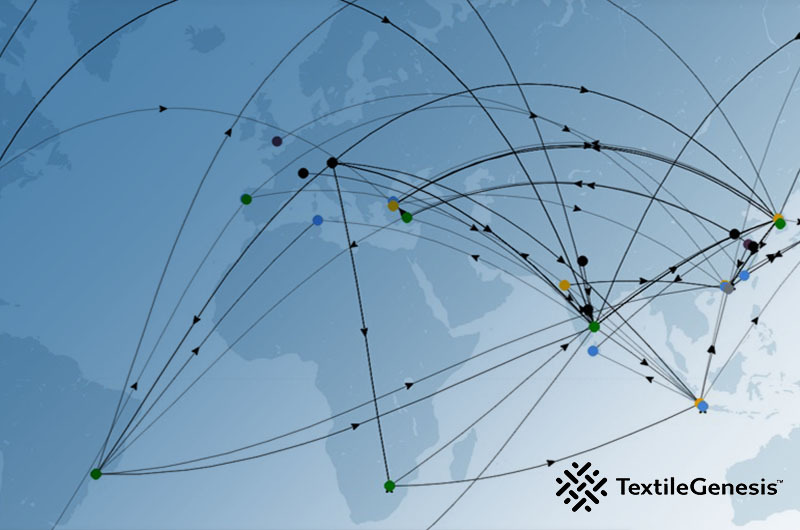In today’s climate, designers don’t just have an opportunity to create beautiful products, they have an obligation to use their informed positions to create innovative fibers, fabrics, design systems, and products that protect our planet.
Of all the ideas within the fashion industry I’ve recently heard, this one stuck out to me the most: No matter their convictions or purchasing habits, no individual consumer can change the 1.34 trillion dollar apparel industry on their own; they can only buy what’s available to them in the market. So the question we, the industry, need to be asking ourselves is: How do we enable consumers to make the best ecological decisions possible?
I believe the answer to this question lives in the practice of circular design. An increasingly used term, circularity can be understood as a series of commitments throughout the product life cycle. Per circularfashion.com,
“Circularity is the idea that products should be designed with high longevity, resource
efficiency, non-toxicity, biodegradability, recyclability and good ethics in mind. They
should be sourced and produced with priority given to local, non-toxic, renewable,
biodegradable and recyclable resources, as well as efficient, safe and ethical practices.
Moreover, the products should be used for as long as possible, through good care,
repair, refurbishment and sharing among multiple users over time (through rent/lease,
secondhand, swap etc). Thereafter, the products should be redesigned to give the
material and components new life. Lastly, the material and components should be
recycled and reused for the manufacturing of new products. If unfit for recycling, the
biological material should instead be composted to become nutrients for plants and
other living organisms in the ecosystem. Overall, the life cycle of products should bring
no environmental or socio-economic harm but instead contribute to positive
development and well-being of humans, ecosystems and societies at large.”1
U.S.-grown cotton is the poster child for a circular-friendly fiber choice for many reasons: clean growing practices, increased fiber strength, superior manufacturing efficiency, increased material durability, market desirability, natural performance benefits, product longevity, and biodegradability. Cotton-rich fabrics and garments are more easily recycled, reused, or composted back into the soil, delivering on circularity’s vision for a product cycle that reduces environmental or socio-economic harm. Leveraging cotton’s inherent superpowers to inform thoughtful product planning and innovative manufacturing techniques provides the industry with a whole new world of exciting, market-viable circular alternatives.
Here are my top choices of circular ideas and initiatives to watch:
Moving Monoliths
When we think about transforming the fashion industry, we can’t shy away from thinking structurally. One organization that has started to move monoliths and disrupt the status quo is the Ellen MacArthur Foundation. A true force for change, they connect business, government, and academia to build a framework for an economy that is restorative and regenerative by design. Through initiatives like Make Fashion Circular, they are engaging industry leaders like Burberry, Gap Inc, H&M, PVH, and Stella McCartney to push the apparel industry towards circular business models and design practices.
One initiative that inspired me in particular is their Jeans Redesign program, which developed and implemented new standards for denim manufacturing by bringing all parts of the design process to the table. By convening leaders from academia, brands, retailers, manufacturers, collectors, sorters, and NGOs, they ensured the adoption of their guidelines would be widespread enough to effect change. By 2021, sixteen leading brands and manufacturers will be following these guidelines to make their jeans.
Legendary Leadership
Similar to the Ellen MacArthur Foundation, brands like Stella McCartney have championed circularity, demanding radical transformation from within the fashion industry. Company-wide, Stella McCartney aims to design waste and pollution out of products, keep materials and products in use longer, and regenerate natural systems.
In addition to their collaboration with The Ellen MacArthur Foundation they are partnering with several other initiatives and organizations as they work to move the industry beyond the linear make-use-dispose design model. Here’s a quick run down of who they are working with:
The Cradle to Cradle Products Innovation Institute
Through their Fashion Positive initiative this organization aims to accelerate circular design through the development of materials that focus on sustainability as measured through material health, material reutilization, renewable energy, carbon management, water stewardship, and social fairness.
This digital platform gives new life to luxury goods through consignment by creating a marketplace for the largest selection of pre-owned luxury items. This partnership is Stella McCartney’s first step to making sure their products never end up as waste. By designing products that are built to last they are transforming the way clothes are produced, sold, shared and reused.
This initiative, developed by H&M and Ginetex, the international association for textile care labeling, aims to help consumers better interpret the symbols on textile care labels - and challenge assumptions on how often clothes need to be washed, dried, ironed, and dry cleaned. The ultimate goal is to help consumers save time, money, energy, and reduce environmental impacts.
Access to Excess
Radical transformation takes time, so identifying the interim steps that can be made now are critical. Recently, I was introduced to the brand Bode, an independent designer, who is doing just that. Emily Bode’s debut collection was made almost entirely of vintage textiles, which responded to the important question: what happens to all the extra yardage created by suppliers? Why do we accept “leftovers” as having no value? By picking up where our industry has historically left unused materials (the landfill), Emily has extended the life cycle of textiles and, in the process, created exquisite garments. (For an insightful conversation between Emily and Eileen Fisher, another industry pioneer, click here.)
Reformation in LA has a similar practice. Close to 15% of their products utilize “deadstock” fabrics, which make up almost 6% of the trash entering U.S. landfills every year. Plus, an additional 2–5% of their garments are made from repurposed vintage clothing. These are the type of steps we need to take to divert existing waste from landfills.
Pulp Non-Fiction: Evernu
I’ll close with one of my favorite recent innovations, one that gets us closer to a circular future. Evernu is a textile innovations company, whose marquee product is NuCycl, a fiber made from discarded cotton clothing. Like Stella McCartney and Emily Bode, the team behind Evernu believes we must eliminate the landfill from the end of the product life cycle. Their guiding question follows a similar tack to the one I posed at the beginning of this article about helping consumers make ecologically-sound decisions. They ask, how do we prevent people from throwing their garments away? Their answer: turn this waste into a regenerative fiber that can be used to make new clothing.
It may seem abstract, turning old clothes into pulp to begin anew, but this concept is already gaining traction. Evernu teamed up with Adidas by Stella McCartney to create a hoodie made 100% of materials diverted from landfills. The Infinite Hoodie is made from 60% NuCycl™ and 40% organic cotton scraps. The most interesting aspect of this garment is that the fabric is made with the intention of it being regenerated again and again. When this sweatshirt is no longer able to be worn, it can be reintroduced to the NuCycl™ process to be re-engineered into new material once again, ultimately multiplying the life of the fiber up to 10 times.
All of these examples point to the momentum building around sustainability, circularity, and what James Carnes, VP of Strategy Creation at adidas, calls, “a waste-free world.” When I think about the crux of the conversation, I always come back to square one: the original source fiber used in any given garment. The quality of the original source is paramount, which is why the work Cotton Council International is doing with US-cotton growers to promote and enable new innovations in quality and sustainability makes so much sense.
As we ask consumers to make new choices about consumption, we must ask ourselves similar questions. Questions like, what materials make our current system more sustainable? Part of the answer is remembering that the ability to regenerate materials, divert waste, and ultimately eliminate landfills, all rely on a designers’ initial fiber choice. The easiest way to break down old fabrics and yarns is if you start with the highest, purest quality fiber at the beginning.




